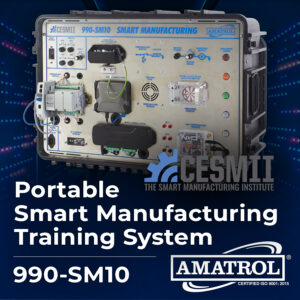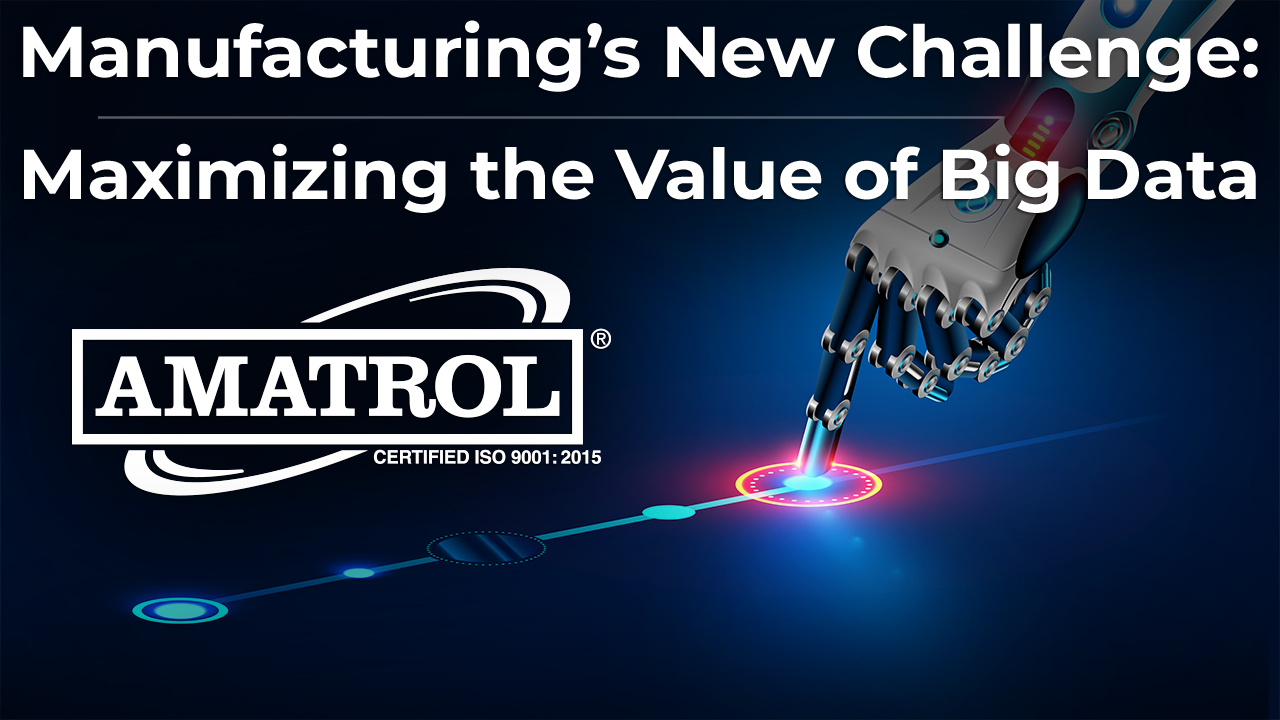“The robots are coming! The robots are coming!” If there were a cry to herald the start of the Fourth Industrial Revolution, it might indeed echo the famous warning often attributed to Paul Revere. Just replace the British with robots and you get the idea.
As Industry 4.0 technologies take hold in the modern manufacturing workplace, however, it’s clear that robots are only part of the revolution transforming yesterday’s manufacturing facilities into today’s smart factories. What’s really at the heart of this new Industrial Revolution?
Data — that’s the common thread tying together all of the advanced automation technologies being implemented in every industry around the globe. In the context of the Industrial Internet of Things (IIoT), the data generated, analyzed, and used to produce exponential increases in productivity and efficiency is often referred to as “big data.”
In this article, we will take a closer look at big data and how manufacturers are being challenged to maximize its value. We’ll also showcase a practical challenge manufacturers face relative to big data and Industry 4.0 technologies: finding workers with the advanced skills they need to thrive in today’s rapidly-changing manufacturing landscape.
What Is Big Data?
Think about the technological advances of the past 20-30 years. We’ve gone from mainframe computers the size of a small house to mobile phones that put the majority of collective human knowledge at your fingertips thanks to the Internet.
We live in a digital world that revolves around data. According to Oracle, “[w]ith the advent of the Internet of Things (IoT), more objects and devices are connected to the internet, gathering data on customer usage patterns and product performance. The emergence of machine learning has produced still more data.”
Businesses focused on appealing to consumers can extract value from all sorts of personal data we all generate, from the websites we visit to the videos we watch on TikTok to the pictures we like on Instagram to the posts we share on Facebook. But what about manufacturers? What can they do with data?
Manufacturing facilities contain a wide variety of sources of important data, including workers themselves as well as the machines they use and interact with. In the context of manufacturing, Oracle points to the “three Vs of big data”: volume, velocity, and variety.
For manufacturers, “[t]he definition of big data is data that contains greater variety, arriving in increasing volumes and with more velocity…Put simply, big data is larger, more complex data sets, especially from new data sources. These data sets are so voluminous that traditional data processing software just can’t manage them. But these massive volumes of data can be used to address business problems you wouldn’t have been able to tackle before.”
The Two New Vs of Big Data
As manufacturers have embraced Industry 4.0 technologies, many have realized that new forms of automation that generate large volumes of data rapidly have created new challenges that manufacturers must face to maximize the return on their investments.
According to Oracle, “[t]wo more Vs have emerged over the past few years: value and veracity. Data has intrinsic value. But it’s of no use until that value is discovered. Equally important: How truthful is your data—and how much can you rely on it?”
With regard to value, Oracle explains:
“Finding value in big data isn’t only about analyzing it (which is a whole other benefit). It’s an entire discovery process that requires insightful analysts, business users, and executives who ask the right questions, recognize patterns, make informed assumptions, and predict behavior.”
As more and more manufacturers try to harness the power of big data, they’re learning that it can open up a whole new world of possibilities. “Big data makes it possible for you to gain more complete answers because you have more information. More complete answers mean more confidence in the data—which means a completely different approach to tackling problems.”
How Can Manufacturers Use Big Data?
One of the hallmarks of the Fourth Industrial Revolution is the exponential leap in efficiency and productivity enabled by the wide variety of advanced technologies now available to manufacturers. But exactly how can manufacturers use big data to see those gains?
As it turns out, there are several ways manufacturers are leveraging big data to their advantage. Here are a few of the most popular, according to Oracle:
- Product Development: “Companies like Netflix and Procter & Gamble use big data to anticipate customer demand. They build predictive models for new products and services by classifying key attributes of past and current products or services and modeling the relationship between those attributes and the commercial success of the offerings. In addition, P&G uses data and analytics from focus groups, social media, test markets, and early store rollouts to plan, produce, and launch new products.”
- Predictive Maintenance: “Factors that can predict mechanical failures may be deeply buried in structured data, such as the year, make, and model of equipment, as well as in unstructured data that covers millions of log entries, sensor data, error messages, and engine temperature. By analyzing these indications of potential issues before the problems happen, organizations can deploy maintenance more cost effectively and maximize parts and equipment uptime.”
- Machine Learning: “Machine learning is a hot topic right now. And data—specifically big data—is one of the reasons why. We are now able to teach machines instead of program them. The availability of big data to train machine learning models makes that possible.”
- Operational Efficiency: “Operational efficiency may not always make the news, but it’s an area in which big data is having the most impact. With big data, you can analyze and assess production, customer feedback and returns, and other factors to reduce outages and anticipate future demands. Big data can also be used to improve decision-making in line with current market demand.
- Drive Innovation: “Big data can help you innovate by studying interdependencies among humans, institutions, entities, and process and then determining new ways to use those insights. Use data insights to improve decisions about financial and planning considerations. Examine trends and what customers want to deliver new products and services. Implement dynamic pricing. There are endless possibilities.”
Maximizing the Value of Big Data
As manufacturers seek to increase operational efficiency, drive product development and innovation, and use predictive maintenance to reduce costs and expensive downtime, sailing isn’t always as smooth as they would like. In fact, maximizing the value of big data is becoming manufacturing’s next big challenge.
In a recent IndustryWeek article, Brian Shepherd, senior vice president of software and control at Rockwell Automation, notes that “[m]anufacturers in a digitized world are surrounded by data that, leveraged correctly, can provide significant intelligence, insight and value to a business. However, if data from smart devices, automation systems and software applications is siloed, it is largely worthless, unable to be fully gathered, analyzed and utilized meaningfully.”
Shepherd believes in the power of big data to transform manufacturing. According to Shepherd, “[b]eing able to leverage and harness data helps companies overcome challenges including supply chain disruptions, labor shortages and rapidly rising energy prices. It contributes to achieving competitive advantage while continuing to deliver value to customers, despite any adversity in the markets.”
However, not all manufacturers know how to maximize the value of the data they collect. Shepherd points out that “what really doesn’t work is an approach that some organizations have tried that is simplistic, expensive and historically has not been shown to have any real value: capturing all data and dumping it into a huge data lake. Artificial intelligence (AI) and machine learning (ML) algorithms are then applied to seek out insights that nobody could have predicted. As appealing as this may be due to its simplicity, it’s generally a pointless exercise.”
Instead, Shepherd believes that “[w]hat really can pay dividends for manufacturers is a structured, well-thought-out and clearly defined data strategy that lays out the answers to some key questions,” such as “what is useful?” and “where is it located?”
Shepherd summarizes the approach manufacturers should take in this way:
“A solid, structured and well-managed data strategy puts data at the center of an organization’s production system and creates a powerful reservoir that can be tapped for many new sources of value. By holistically harnessing the combined power of data, expertise and advanced technologies such as AI and ML, manufacturers can optimize their entire operations. This can power tangible benefits and business outcomes for the organization, with actionable insights, across the manufacturing lifecycle—from the design of new production system elements to shipping the finished product.”
Examples of Manufacturers Making the Most of Big Data
As challenging as maximizing the value of big data can be, some manufacturers have already made great strides in utilizing big data to impressive ends. For example, in a Consumer Goods Technology article, author Lisa Johnston details how “Hormel Foods is investing in real-time data sharing to improve on-shelf availability with its retail partners.”
Johnston notes that the company “partnered with [a] retail analytics platform provider…to more quickly obtain and analyze insights and simplify the data pipeline architecture.” The result? “With the technology, Hormel Foods can both share and tap into historical and real-time data insights in Google Cloud from retailers, including delivery, retail, supply chain, manufacturing, and inventory data. As a result of the automation, the company has improved data accessibility, speed of delivery, quality, and breadth, according to…Mark Vaupel, VP IT services at Hormel Foods.”
Practically, “[b]y integrating disparate data sources to receive full and real-time visibility into physical shelf performance, Hormel Foods can better inform its retail customers about potential out-of-stock issues and help reduce food waste.”
In another Consumer Goods Technology article, author Liz Dominguez profiles another company focused on digital transformation: Procter & Gamble. According to Dominguez, “P&G has heavily invested in its supply chain’s digital capability over the past several years, and is looking to tap into those investments to drive productivity and cost effectiveness.”
Dominguez notes that, by “[i]mplementing AI, machine learning, and edge computing services, P&G will have greater visibility and be able to digitize and integrate data from more than 100 manufacturing sites globally. This will enable the company’s employees to analyze production data and make real-time, data-informed decisions to drive significant improvements.”
The Importance of Workers with Industry 4.0 Skills
The challenges facing manufacturers trying to maximize the value of big data go beyond the conceptual difficulties of developing strategies to effectively collect, analyze, and utilize data. In fact, possibly the biggest challenge facing manufacturers related to big data is finding highly-skilled workers who are qualified to work with advanced Industry 4.0 technologies.
The National Association of Manufacturers’ (NAM) Manufacturing Leadership Council (MLC) recently released its Manufacturing in 2030 White Paper: The Next Phase of Digital Evolution (“MLC White Paper”), in which it notes:
“New skills and roles will be needed to apply, operate, manage, and benefit from these new tools. New approaches to redefining human machine relationships will be needed for employees at all levels to best leverage advanced technologies for both personal and company improvement. And leadership teams will need to develop more digital acumen as they strive to master the vast amounts of data that will be available and harness the exponentially increasing digital power at their fingertips to create fruitful new business models and engaging customer experiences.”
Indeed, the many new advanced automation technologies at the heart of Industry 4.0 will need highly-skilled workers to operate, maintain, troubleshoot, and repair them. That means a variety of new roles will need to be filled in addition to the many open positions already available in manufacturing.
According to the MLC White Paper, “up to 65% of the job roles that will exist in 2030 don’t yet exist today. As alarming as that sounds, consider that 63% of jobs done in 2018 did not exist in 1940, according to the U.S. census. Many new manufacturing jobs will merely be an evolution of those that exist today – augmented by connected machines, AI, and advanced analytics.”
This may be concerning for some manufacturers who view finding highly-skilled employees as a challenge. Fortunately, the training experts at Amatrol are ahead of the curve on developing training systems to teach students and current workers the advanced automation skills they’ll need to succeed in the future manufacturing workspace.
Amatrol Leads the Way in Next-Generation Industry 4.0 Training
If you’re an educator looking to adequately train the next generation of manufacturing technicians or an employer needing to upskill your current workforce, you don’t have to recreate the wheel when it comes to hands-on skill training with advanced automation technologies.
Smart Factory
Amatrol pioneered Industry 4.0 training when it transformed its popular full-scale mechatronics line into a robust Smart Factory training system. The Smart Factory is a fully connected and flexible manufacturing system that connects its physical systems, operational information, and human assets to control manufacturing, maintenance, inventory, and supply chain operations.
The linked mechatronics stations incorporate all major manufacturing technologies, including electrical, mechanical, hydraulics, and pneumatics. Together, the stations comprise a fully-automated manufacturing line that teaches essential processes, such as inventory control, inspection, sorting, assembly, torqueing, testing, CNC machining, and storage.
To transform this system into a true Smart Factory, Amatrol added a station for networking communications equipment, along with a variety of other connected technologies, such as: smart sensors; smart product ID; network communications & security; and smart production & maintenance software.

Smart Factory Enterprise
In order to meet the need for hands-on training with a seamless system in which all the parts work together, just like learners will face on the job, Amatrol added an autonomous robot system, smart robot workcells, and a smart conveyor system to its Smart Factory to develop the groundbreaking Smart Factory Enterprise training system.
Amatrol’s Smart Factory Enterprise represents true connected systems training at the enterprise level. Using Amatrol’s Smart Factory Enterprise System, learners will gain real, relevant Industry 4.0 skills and experience, because they’ll be working with industry-standard components integrated in an enterprise system that replicates an authentic Smart Factory.
Click below to see Smart Factory Enterprise in action:
Flexible Smart Automation Training

For educational institutions or businesses looking to teach advanced automation skills on a smaller scale or with greater flexibility, Amatrol also offers a variety of convenient training systems that pack a powerful punch in a smaller package.
For example, Amatrol’s Tabletop Smart Factory training system offers Industry 4.0 training in a compact, portable system that’s perfect for high schools or anywhere training space is limited. The five-station system includes Smart Factory components for Ethernet, RFID/Sensors, Barcode, and more. It also connects with Amatrol’s Portable PLC Troubleshooting Learning System – AB Compact Logix (990-PABCL1F), which provides performance analysis of the system via I/O Link.
Most recently, Amatrol launched its new portable Smart Manufacturing training system (990-SM10), developed in partnership with CESMII — The Smart Manufacturing Institute. The new portable Smart Manufacturing trainer offers hands-on Industry 4.0 applications, such as wireless temperature monitoring; web-based condition and power monitoring; and wireless production counting.

It also boasts a variety of real-world industrial components workers will encounter on the job, including: BorgConnect Hub, BorgConnect Node, Ethernet switch-5-port, Allen-Bradley Micro820 Programmable Controller, AC current sensor, load cell/parts counter, and a Wi-Fi temperature sensor.
If you’re ready to train your students or current workers for the highly-skilled jobs available today in smart manufacturing, consult with an expert at Amatrol to learn how you can take the first step toward teaching the skills that will set them up for success in the modern workplace.
About Duane Bolin
Duane Bolin is a former curriculum developer and education specialist. He is currently a Marketing Content Developer in the technical training solutions market.





